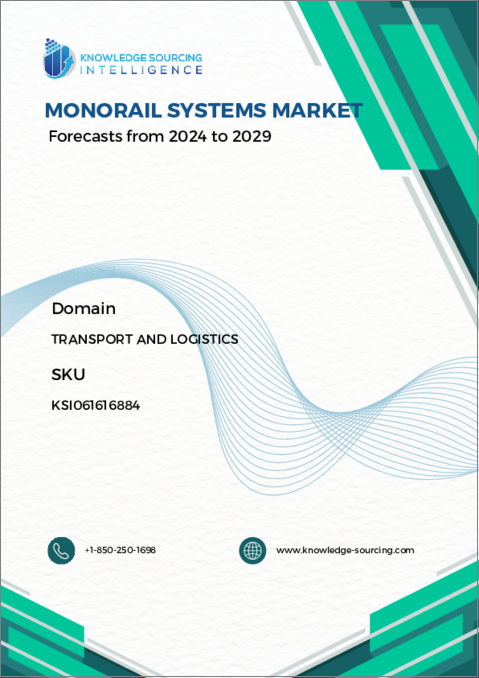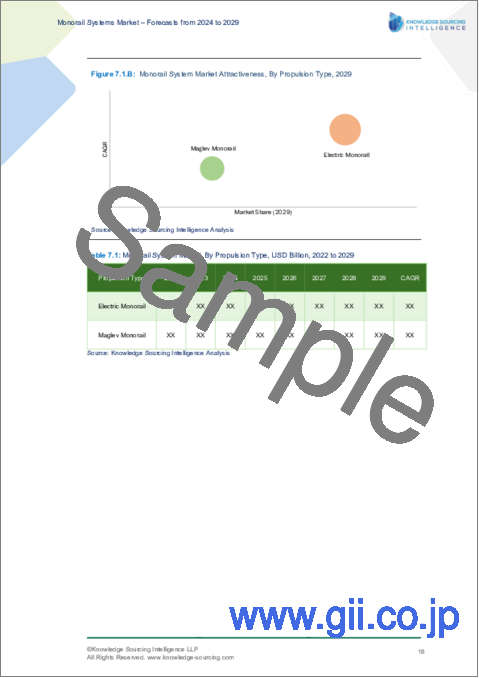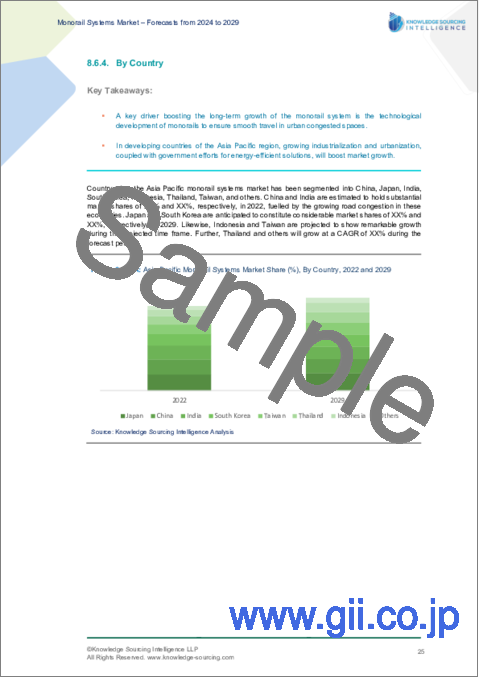|
|
市場調査レポート
商品コード
1496052
モノレールシステム市場-2024年から2029年までの予測Monorail Systems Market - Forecasts from 2024 to 2029 |
||||||
カスタマイズ可能
|
|||||||
| モノレールシステム市場-2024年から2029年までの予測 |
|
出版日: 2024年05月16日
発行: Knowledge Sourcing Intelligence
ページ情報: 英文 141 Pages
納期: 即日から翌営業日
|
全表示
- 概要
- 目次
モノレールシステム市場は、予測期間中にCAGR 4.23%で成長し、2022年の69億8,100万米ドルから2029年には93億2,900万米ドルになると予測されています。
モノレールは、旅客用の列車や機関車の一種で、運行する線路は1本のみで、電気で自動的に動くため運転手はいないです。これらの機関車やレールは一般に、道路の混雑を避け、勤務時間中の忙しい乗客に高速移動を提供するため、地上高く、大都市に建設されます。これらのモノレールは、大都市内を通勤するためにこれらのレールを毎日利用する乗客に安い運賃を提供し、乗客がモノレールを利用することを便利で効率的なものにしています。モノレール機関車が支持される1本のレール・ビームや軌道は、一般的に運行される高所でも機関車の重量を支えることができるように作られています。
モノレールの軌道に使用されるこの高品質な素材は、乗客の安全性を確保し、モノレールを利用する乗客に信頼を与えます。モノレールは、ディーゼルのような化石燃料のエネルギー資源を使用するのではなく、電気で走行するため、エネルギー効率が高く、環境への有害な影響を軽減することができます。これらのモノレールは、空港への通勤を容易にするために、地域の複数の都市とその地域の共通の空港を結ぶことができるなど、さまざまなエンドユーザーや用途で広く採用されています。
モノレールシステム市場イントロダクション:
モノレール・システム市場は、モノレールの効率と速度を向上させた機関車とモノレール技術の長年にわたる発展によって牽引されています。モノレールシステムにおける技術開発の成長により、モノレールは地下鉄に比べてインフラが少なくて済み、モノレールを開発する際の費用対効果も高いことから、世界中のいくつかの政府がこれらのモノレールを採用するようになった。これらのモノレールは運転手なしで電気で走るため、複数の地域で採用されている主な理由の一つとなっています。
気候変動や地球温暖化といった深刻な環境問題を背景に、エネルギー効率が高く環境に優しい代替手段へのニーズが高まっています。高速で費用対効果の高い公共交通機関へのニーズは、道路が混雑し、交通量が多いため、一般市民の間で就業時間中の移動のために高まっています。モノレールシステムは、都市間の高速移動を費用対効果の高い方法で提供することで、この問題を解決できるため、モノレールシステム市場は予測期間中に成長すると予測されます。
モノレールシステム市場の促進要因:
- 世界中でモノレールの技術開発が進み、市場が拡大すると予測されます。
地球温暖化や気候変動のようなさまざまな環境問題の増加に伴い、費用対効果が高くエネルギー効率の高い鉄道ソリューションへの需要が高まっています。したがって、これらのモノレールは、一般市民に高い安全性と費用対効果の高い移動を提供する一方で、世界的にエネルギー効率とカーボンフットプリントの削減を提供する運転に電力を使用することによって環境への有害な影響を低減するために開発されています。したがって、モノレール・システム技術の成長は、予測期間中の市場成長を促進すると予想されます。
- 道路の混雑と交通量の増加がモノレールシステム市場を牽引すると予測されます。
世界中で人口が増加しているため、いくつかの国の経済成長と一般市民の可処分所得の上昇に伴い、自動車の普及が進んでいます。その結果、道路の混雑や渋滞が激しくなり、日常的な利用者が道路を移動する場合、営業時間内にオフィスなどの必要な場所に時間通りに到着することが難しくなっています。したがって、このような交通事情が世界的に拡大したことで、ビジネス時間帯に費用対効果が高く、迅速な移動が可能なモノレールシステムが大都市に設置される需要が高まっています。
モノレールシステム市場の抑制要因:
- 高い維持費と一般市民の認識不足が市場の成長を抑制する可能性
モノレールシステム市場は、さまざまな都市や近距離の一般市民のための公共交通サービスを向上させ、乗客に費用対効果の高い安全な移動を提供するという重要な役割を担っているにもかかわらず、これらのモノレールシステムのメーカーが直面する可能性のあるさまざまな課題が、予測期間中にモノレールシステム市場にマイナスの影響を与える可能性があります。例えば、大都市におけるモノレール・プロジェクトの開発には、都市に応じたルートと効果的なモノレール・システムを設計・開発するための高コストの要件が必要です。
多額の投資と長い開発期間を経てモノレール・システムが故障すると、メーカーだけでなく、都市にモノレールを開発するために投資した政府にとっても大きな損失につながります。また、モノレールの定期的なメンテナンスと安全点検のための余分なコストも必要だが、モノレールに対する一般市民の認識不足やモノレールの受容率の低さによって、モノレールがその地域で失敗した場合、メーカーに莫大な損失をもたらす可能性があります。したがって、こうした要因が予測期間中のモノレールシステム市場の成長を妨げると予想されます。
モノレールシステム市場- 地理的展望
- 成長はアジア太平洋地域で顕著になると予測されます。
アジア太平洋地域は、アジア太平洋地域のいくつかの国々で工業化と都市化が進み、同地域の新興国において効率的な鉄道ソリューションに対するニーズが急速に高まっていることから、モノレールシステム市場の大きな成長が見込まれています。エネルギー効率の高いソリューションを推進する政府の政策や、鉄道のような公共交通機関の排ガス規制に関する厳しい政策が、さまざまな鉄道メーカーにモノレールのようなエネルギー効率の高い鉄道ソリューションを開発させています。
中国やインドなどの国々では人口が増加しているため、人口増加による道路の混雑を回避できるモノレールのニーズが高まっています。日本の日立レールのような効果的なモノレールシステムを開発する主要鉄道メーカーの存在が、この地域のモノレールシステム市場の成長に大きく貢献しています。
モノレールシステム市場のプレーヤーと製品
- 日立レール:モノレールは、東京空港と複数の都市を結ぶ東京モノレールのように、大都市に設置されています。日立レールが提供するモノレール・ソリューションは、電気で走るため環境に優しく、シンプルな設計のため使いやすく、大都市を移動する多くの乗客に快適さを提供しています。
- アルストム:Innoviaモノレール・システムは、大都市へのInnovaモノレール・システムの容易な統合と相まって、費用対効果に優れた迅速な製造を提供します。このモノレール・システムは、モノレールシステムで旅する乗客にとってより静かで快適な最新技術で作られています。このモノレール・システムは、インフラストラクチャーで安全性を確保しながら、長距離と短距離の移動にわたって大容量の乗客を収容することができます。
モノレール・システム業界の最新情報
- 2023年12月、アルストムは、バンコクの地下鉄34.5キロメートルのピンクラインに自動運転モノレールシステムInnoviaを導入すると発表しました。このモノレールは運転手がおらず、時速80キロで走行し、同時に約47万人の乗客を運ぶことができます。これにより、鉄道路線の接続が改善され、乗客の移動時間が50%短縮され、平均1時間未満となります。
モノレール市場は次のようにセグメント化され、分析されている:
タイプ別
- 跨座式モノレール
- 吊り下げ式モノレール
自律性別
- 半自律型
- 完全自律型
- 手動型
推進タイプ別
- 電気式モノレール
- 磁気浮上式モノレール
地域別
- 北米
- 米国
- カナダ
- メキシコ
- 南米
- ブラジル
- アルゼンチン
- その他
- 欧州
- 英国
- ドイツ
- フランス
- イタリア
- スペイン
- その他
- 中東・アフリカサウジアラビアカナダメキシコ南米ブラジルアルゼンチンその他欧州英国ドイツフランスイタリアスペインその他中東・アフリカ
- サウジアラビア
- UAE
- その他
- アジア太平洋
- 日本
- 中国
- インド
- 韓国
- 台湾
- タイ
- インドネシア
- その他
目次
第1章 イントロダクション
- 市場概要
- 市場の定義
- 調査範囲
- 市場セグメンテーション
- 通貨
- 前提条件
- 基準年と予測年のタイムライン
- ステークホルダーにとっての主なメリット
第2章 調査手法
- 調査デザイン
- 調査プロセス
第3章 エグゼクティブサマリー
- 主な調査結果
第4章 市場力学
- 市場促進要因
- 市場抑制要因
- ポーターのファイブフォース分析
- 業界バリューチェーン分析
- アナリストビュー
第5章 モノレールシステム市場:タイプ別
- イントロダクション
- 跨座式モノレール
- 市場動向と機会
- 成長の見通し
- 地理的な利益性
- 懸垂式モノレール
- 市場動向と機会
- 成長の見通し
- 地理的な利益性
第6章 モノレールシステム市場:自律性別
- イントロダクション
- 半自律型
- 市場動向と機会
- 成長の見通し
- 地理的な利益性
- 完全自律型
- 市場動向と機会
- 成長の見通し
- 地理的な利益性
- マニュアル
- 市場動向と機会
- 成長の見通し
- 地理的な利益性
第7章 モノレールシステム市場:推進タイプ別
- イントロダクション
- 電気モノレール
- 市場動向と機会
- 成長の見通し
- 地理的な利益性
- 磁気浮上式モノレール
- 市場動向と機会
- 成長の見通し
- 地理的な利益性
第8章 モノレールシステム市場:地域別
- イントロダクション
- 北米
- タイプ別
- 自律性別
- 推進タイプ別
- 国別
- 南米
- タイプ別
- 自律性別
- 推進タイプ別
- 国別
- 欧州
- タイプ別
- 自律性別
- 推進タイプ別
- 国別
- 中東・アフリカ
- タイプ別
- 自律性別
- 推進タイプ別
- 国別
- アジア太平洋
- タイプ別
- 自律性別
- 推進タイプ別
- 国別
第9章 競合環境と分析
- 主要企業と戦略分析
- 市場シェア分析
- 合併、買収、合意およびコラボレーション
- 競合ダッシュボード
第10章 企業プロファイル
- Alstom
- Hitachi Rail
- Rostek
- Storee Construction Co.
- Atlas Anchor Systems
- Pentanova
- AFE Crane
- Munck Cranes
- Metreel
- Mese Group
The monorail systems market is projected to grow at a CAGR of 4.23%, from US$6.981 billion in 2022 to US$9.329 billion in 2029 during the forecast period.
Monorails are a type of train or locomotive for passenger travel that only has one track that it operates on and has no driver because it works on electricity and automatically. These locomotives or rails are generally built high above the ground and in metropolitan cities to avoid congestion on the road and provide fast travel for busy passengers during working hours. These monorails offer cheap fare to the passengers that travel daily on these rails to commute within the metropolitan cities which makes it convenient and efficient for the passenger to use them. The single rail beam or track that the monorail locomotive is supported by is made such that it can support the weight of that locomotive at high altitudes where it generally operates.
This high-quality material for the tracks of monorails ensures the safety of the passengers and thus provides trust in them to use these monorails. The monorails run on electricity rather than using fossil fuel energy resources like diesel which makes them more energy efficient and reduces the harmful impact on the environment. These monorail systems are widely adopted across different end-users and applications such as for easy commute to airports these monorails can connect several cities in a region to the common airport of that region.
MONORAIL SYSTEMS MARKET INTRODUCTION:
The monorail system market is driven by the growing developments in locomotive and monorail technology over the years which has increased the efficiency and speed of the monorail. The growth in the technological developments in monorail systems has led several governments across the globe to adopt these monorails as they require less infrastructure compared to the metro and are more cost-effective while developing monorails. These monorails run on electricity without any drivers, which is one of the key reasons for their adoption across several regions.
The need for energy-efficient and eco-friendly alternatives is growing in popularity with severe environmental issues like climate change and global warming. The need for high-speed and cost-effective public transport is increasing among the general public for traveling during work hours as the roads are too congested and a lot of traffic is on the road. The monorail systems can solve this problem by providing high-speed travel across the cities in a cost-effective manner, which is why the market for monorail systems is predicted to grow over the forecast period.
MONORAIL SYSTEMS MARKET DRIVERS:
- Growth in the technological development of monorails across the globe is predicted to propel the market.
The demand for cost-effective and energy-efficient railway solutions is increasing with the growth in different environmental issues like global warming and climate change. Hence, these monorails are developed to provide the general public with high safety and cost-effective travel while reducing harmful impact on the environment by using electricity to operate providing energy-efficiency and reduction of carbon footprint globally. Hence, the growth in monorail system technology is expected to fuel the market growth over the forecast period.
- The growing congestion and traffic on roads are projected to drive the monorail systems market.
The growing global population across the globe has resulted in the widespread adoption of automobiles with growth in economies of several countries and rising disposable incomes among the general public. This has led to high congestion and traffic on the road which makes it difficult for daily passengers to reach the required location like office during business hours on time if they travel by road. Hence, the growth in these traffic conditions across the globe has driven the demand for monorail systems to be installed in metropolitan cities that can provide cost-effective and fast travel during business hours.
MONORAIL SYSTEMS MARKET RESTRAINT:
- High maintenance costs and lack of awareness among the public can restrain market growth
The monorail systems market, despite having an important role in improving the public transport services for the general public across the different cities and short-range distances providing cost-effective and safe travel for passengers, can lead to various challenges that can be faced by the manufacturers of these monorails system that may impact the monorail systems market negatively over the forecast period. For instance, the high-cost requirement for the development of monorail projects in metropolitan cities is needed to design and develop the route and effective monorail system according to the city.
The failure of the monorail system after having a large investment and long development time can lead to great loss for the manufacturer as well as the governments that invested in the monorails to be developed in their cities. The extra cost requirement of regular maintenance and safety checkups of the monorails is also necessary, but if the monorail has failed in the region due to lack of awareness among the general public about it or low acceptance rate for monorails can create huge losses for manufacturers. Hence, these factors are expected to hinder the monorail systems market growth over the forecast period.
MONORAIL SYSTEMS MARKET - GEOGRAPHICAL OUTLOOK
- The growth is projected to be prominent in the Asia Pacific region.
The Asia Pacific region is expected to show major growth in the monorail systems market due to the rapid increase in the need for efficient rail solutions in developing countries in the region with growing industrialization and urbanization in several countries across the Asia Pacific region. The government policies that promote energy-efficient solutions and strict regulations regarding emission control from public transport like railways are making different railway manufacturers develop energy-efficient railway solutions as monorails.
The growth in population in countries like China and India is leading to a growth in the need for monorails that can help the public avoid road congestion due to high population growth. The presence of key railway manufacturers that develop effective monorail systems, like Hitachi Rail from Japan, is contributing to the monorail system market growth significantly in this region.
Monorail System Market Players and Products:
- Hitachi Rail: The monorails are installed in metro cities like the Tokyo monorail which connects several cities with the Tokyo airport. The monorail solutions offered by Hitachi Rail are environmentally friendly as they run on electricity, they are simple in design which makes them easy to use, and they provide comfort to the large number of passengers that the monorail solution can carry around the metropolitan cities.
- Alstom: The Innovia monorail system provides cost-effective and fast manufacturing coupled with easy integration of the Innova monorail system into the metropolitan cities. This monorail system is made from modern technology that is quieter and more comfortable for passengers traveling in the monorail systems. This monorail system can accommodate high-capacity passengers across long-range and short-range travel while ensuring safety with its infrastructure.
Monorail System Industry Updates:
- In December 2023, Alstom announced the launch of their automated Innovia monorail system at the Bangkok metro's 34.5-kilometer pink line. This monorail is driverless and can go up to the speed of 80 km/hr while carrying around 470,000 passengers at the same time. This will improve the connection of rail lines and reduce the passenger travel time by 50%, which is under an hour on average.
The Monorail System market is segmented and analyzed as:
By Type
- Straddle Monorail
- Suspended Monorail
By Autonomy
- Semi-Autonomous
- Completely Autonomous
- Manual
By Propulsion Type
- Electric Monorail
- Maglev Monorail
By Geography
- North America
- United States
- Canada
- Mexico
- South America
- Brazil
- Argentina
- Others
- Europe
- United Kingdom
- Germany
- France
- Italy
- Spain
- Others
- Middle East and Africa
- Saudi Arabia
- UAE
- Others
- Asia Pacific
- Japan
- China
- India
- South Korea
- Taiwan
- Thailand
- Indonesia
- Others
TABLE OF CONTENTS
1. INTRODUCTION
- 1.1. Market Overview
- 1.2. Market Definition
- 1.3. Scope of the Study
- 1.4. Market Segmentation
- 1.5. Currency
- 1.6. Assumptions
- 1.7. Base and Forecast Years Timeline
- 1.8. Key Benefits to the Stakeholder
2. RESEARCH METHODOLOGY
- 2.1. Research Design
- 2.2. Research Processes
3. EXECUTIVE SUMMARY
- 3.1. Key Findings
4. MARKET DYNAMICS
- 4.1. Market Drivers
- 4.2. Market Restraints
- 4.3. Porter's Five Forces Analysis
- 4.3.1. Bargaining Power of Suppliers
- 4.3.2. Bargaining Power of Buyers
- 4.3.3. Threat of New Entrants
- 4.3.4. Threat of Substitutes
- 4.3.5. Competitive Rivalry in the Industry
- 4.4. Industry Value Chain Analysis
- 4.5. Analyst View
5. MONORAIL SYSTEMS MARKET BY TYPE
- 5.1. Introduction
- 5.2. Straddle Monorail
- 5.2.1. Market Trends and Opportunities
- 5.2.2. Growth Prospects
- 5.2.3. Geographic Lucrativeness
- 5.3. Suspended Monorail
- 5.3.1. Market Trends and Opportunities
- 5.3.2. Growth Prospects
- 5.3.3. Geographic Lucrativeness
6. MONORAIL SYSTEMS MARKET BY AUTONOMY
- 6.1. Introduction
- 6.2. Semi-autonomous
- 6.2.1. Market Trends and Opportunities
- 6.2.2. Growth Prospects
- 6.2.3. Geographic Lucrativeness
- 6.3. Completely Autonomous
- 6.3.1. Market Trends and Opportunities
- 6.3.2. Growth Prospects
- 6.3.3. Geographic Lucrativeness
- 6.4. Manual
- 6.4.1. Market Trends and Opportunities
- 6.4.2. Growth Prospects
- 6.4.3. Geographic Lucrativeness
7. MONORAIL SYSTEMS MARKET BY PROPULSION TYPE
- 7.1. Introduction
- 7.2. Electric Monorail
- 7.2.1. Market Trends and Opportunities
- 7.2.2. Growth Prospects
- 7.2.3. Geographic Lucrativeness
- 7.3. Maglev Monorail
- 7.3.1. Market Trends and Opportunities
- 7.3.2. Growth Prospects
- 7.3.3. Geographic Lucrativeness
8. MONORAIL SYSTEMS MARKET BY GEOGRAPHY
- 8.1. Introduction
- 8.2. North America
- 8.2.1. By Type
- 8.2.2. By Autonomy
- 8.2.3. By Propulsion Type
- 8.2.4. By Country
- 8.2.4.1. United States
- 8.2.4.1.1. Market Trends and Opportunities
- 8.2.4.1.2. Growth Prospects
- 8.2.4.2. Canada
- 8.2.4.2.1. Market Trends and Opportunities
- 8.2.4.2.2. Growth Prospects
- 8.2.4.3. Mexico
- 8.2.4.3.1. Market Trends and Opportunities
- 8.2.4.3.2. Growth Prospects
- 8.2.4.1. United States
- 8.3. South America
- 8.3.1. By Type
- 8.3.2. By Autonomy
- 8.3.3. By Propulsion Type
- 8.3.4. By Country
- 8.3.4.1. Brazil
- 8.3.4.1.1. Market Trends and Opportunities
- 8.3.4.1.2. Growth Prospects
- 8.3.4.2. Argentina
- 8.3.4.2.1. Market Trends and Opportunities
- 8.3.4.2.2. Growth Prospects
- 8.3.4.3. Others
- 8.3.4.3.1. Market Trends and Opportunities
- 8.3.4.3.2. Growth Prospects
- 8.3.4.1. Brazil
- 8.4. Europe
- 8.4.1. By Type
- 8.4.2. By Autonomy
- 8.4.3. By Propulsion Type
- 8.4.4. By Country
- 8.4.4.1. United Kingdom
- 8.4.4.1.1. Market Trends and Opportunities
- 8.4.4.1.2. Growth Prospects
- 8.4.4.2. Germany
- 8.4.4.2.1. Market Trends and Opportunities
- 8.4.4.2.2. Growth Prospects
- 8.4.4.3. France
- 8.4.4.3.1. Market Trends and Opportunities
- 8.4.4.3.2. Growth Prospects
- 8.4.4.4. Italy
- 8.4.4.4.1. Market Trends and Opportunities
- 8.4.4.4.2. Growth Prospects
- 8.4.4.5. Spain
- 8.4.4.5.1. Market Trends and Opportunities
- 8.4.4.5.2. Growth Prospects
- 8.4.4.6. Others
- 8.4.4.6.1. Market Trends and Opportunities
- 8.4.4.6.2. Growth Prospects
- 8.4.4.1. United Kingdom
- 8.5. Middle East and Africa
- 8.5.1. By Type
- 8.5.2. By Autonomy
- 8.5.3. By Propulsion Type
- 8.5.4. By Country
- 8.5.4.1. Saudi Arabia
- 8.5.4.1.1. Market Trends and Opportunities
- 8.5.4.1.2. Growth Prospects
- 8.5.4.2. UAE
- 8.5.4.2.1. Market Trends and Opportunities
- 8.5.4.2.2. Growth Prospects
- 8.5.4.3. Others
- 8.5.4.3.1. Market Trends and Opportunities
- 8.5.4.3.2. Growth Prospects
- 8.5.4.1. Saudi Arabia
- 8.6. Asia Pacific
- 8.6.1. By Type
- 8.6.2. By Autonomy
- 8.6.3. By Propulsion Type
- 8.6.4. By Country
- 8.6.4.1. Japan
- 8.6.4.1.1. Market Trends and Opportunities
- 8.6.4.1.2. Growth Prospects
- 8.6.4.2. China
- 8.6.4.2.1. Market Trends and Opportunities
- 8.6.4.2.2. Growth Prospects
- 8.6.4.3. India
- 8.6.4.3.1. Market Trends and Opportunities
- 8.6.4.3.2. Growth Prospects
- 8.6.4.4. South Korea
- 8.6.4.4.1. Market Trends and Opportunities
- 8.6.4.4.2. Growth Prospects
- 8.6.4.5. Taiwan
- 8.6.4.5.1. Market Trends and Opportunities
- 8.6.4.5.2. Growth Prospects
- 8.6.4.6. Thailand
- 8.6.4.6.1. Market Trends and Opportunities
- 8.6.4.6.2. Growth Prospects
- 8.6.4.7. Indonesia
- 8.6.4.7.1. Market Trends and Opportunities
- 8.6.4.7.2. Growth Prospects
- 8.6.4.8. Others
- 8.6.4.8.1. Market Trends and Opportunities
- 8.6.4.8.2. Growth Prospects
- 8.6.4.1. Japan
9. COMPETITIVE ENVIRONMENT AND ANALYSIS
- 9.1. Major Players and Strategy Analysis
- 9.2. Market Share Analysis
- 9.3. Mergers, Acquisitions, Agreements, and Collaborations
- 9.4. Competitive Dashboard
10. COMPANY PROFILES
- 10.1. Alstom
- 10.2. Hitachi Rail
- 10.3. Rostek
- 10.4. Storee Construction Co.
- 10.5. Atlas Anchor Systems
- 10.6. Pentanova
- 10.7. AFE Crane
- 10.8. Munck Cranes
- 10.9. Metreel
- 10.10. Mese Group





